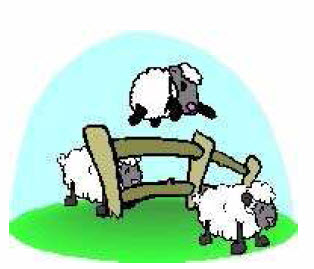Counting Sheep
Time Limit : 2000/1000ms (Java/Other) Memory Limit : 32768/32768K (Java/Other)
Total Submission(s) : 14 Accepted Submission(s) : 12
Font: Times New Roman | Verdana | Georgia
Font Size: ← →
Problem Description
A while ago I had trouble sleeping. I used to lie awake, staring at the ceiling, for hours and hours. Then one day my grandmother suggested I tried counting sheep after I'd gone to bed. As always when my grandmother suggests things, I decided to try it out. The only problem was, there were no sheep around to be counted when I went to bed.
Now, I've got a new problem. Though counting these sheep actually helps me fall asleep, I find that it is extremely boring. To solve this, I've decided I need another computer program that does the counting for me. Then I'll be able to just start both these programs before I go to bed, and I'll sleep tight until the morning without any disturbances. I need you to write this program for me.

Now, I've got a new problem. Though counting these sheep actually helps me fall asleep, I find that it is extremely boring. To solve this, I've decided I need another computer program that does the counting for me. Then I'll be able to just start both these programs before I go to bed, and I'll sleep tight until the morning without any disturbances. I need you to write this program for me.
Input
The first line of input contains a single number T, the number of test cases to follow.
Each test case begins with a line containing two numbers, H and W, the height and width of the sheep grid. Then follows H lines, each containing W characters (either # or .), describing that part of the grid.
Each test case begins with a line containing two numbers, H and W, the height and width of the sheep grid. Then follows H lines, each containing W characters (either # or .), describing that part of the grid.
Output
For each test case, output a line containing a single number, the amount of sheep flock son that grid according to the rules stated in the problem description.
Notes and Constraints 0 < T <= 100 0 < H,W <= 100
Notes and Constraints 0 < T <= 100 0 < H,W <= 100
Sample Input
2
4 4
#.#.
.#.#
#.##
.#.#
3 5
###.#
..#..
#.###
Sample Output
6
3
Source
IDI Open 2009
1 #include <stdio.h> 2 #include <string.h> 3 char map[105][105]; 4 int f[4][2] = {1,0,-1,0,0,1,0,-1}; //注意定义方向数组。只有四个方向上下左右。 5 int n,m,s; 6 void dfs(int x,int y) 7 { 8 int i; 9 int x1,y1; 10 for(i = 0;i<4;i++) 11 { 12 x1= x+f[i][0]; 13 y1 = y+f[i][1]; 14 if(x1<0 || y1<0 || x1>=n || y1>=m || map[x1][y1]!='#') 15 continue; 16 map[x1][y1] = '.'; 17 dfs(x1,y1); 18 } 19 } 20 21 int main() 22 { 23 int t; 24 scanf("%d",&t); 25 while(t--) 26 { 27 scanf("%d%d",&n,&m); 28 int i,j,l; 29 s = 0; 30 for(i = 0;i<n;i++) 31 { 32 scanf("%s",map[i]); 33 } 34 for(i = 0;i<n;i++) 35 { 36 for(j = 0;j<m;j++) 37 { 38 if(map[i][j] == '#') 39 { 40 s++; 41 map[i][j] = '.'; 42 dfs(i,j); 43 } 44 } 45 } 46 printf("%d ",s); 47 } 48 49 return 0; 50 }